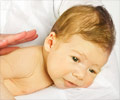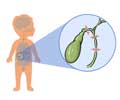Signs, Symptoms and Diagnosis Crigler-Najjar Syndrome
Type 1 Crigler-Najjar syndrome is characterised by intense jaundice in the first days of life.
Signs and Symptoms of Crigler-Najjar Syndrome
Type 1 Crigler-Najjar syndrome is characterised by intense jaundice with yellow discoloration of the skin and eyes in the first days of life. This jaundice, also called icterus, persists thereafter. Accumulation of bilirubin (especially a water insoluble form called unconjugated bilirubin) in the brain damages it leading to confusion and changes in thinking. This could be followed by a severe form of brain damage called kernicterus (bilirubin encephalopathy). Symptoms of kernicterus include low muscle tone, deafness and lethargy. The condition is often fatal. Before the advent of phototherapy, most patients with Crigler-Najjar syndrome type 1 died of kernicterus in infancy or early childhood.
Crigler-Najjar syndrome type 2 is less severe andappears later in life, usually in late infancy or childhood. Though uncommon, kernicterus can occur in all ages. Patients with type 2 disease may rarely develop kernicterus during conditions like fasting, intercurrent illness etc.
Diagnosis of Crigler-Najjar Syndrome
Diagnosis of Crigler-Najjar syndrome is based on tests that assess liver function. These include:
- Measurement of conjugated (bound) and unconjugated (unbound) bilirubin in blood. Total bilirubin level is also measured.
- Liver biopsy
- Enzyme assay- in which the level of the enzyme uridine diphosphate glucuronosyl transferase is assessed.
Clinical suspicion may be made when jaundice develops on the first day of birth (pathological jaundice) and persists thereafter. The jaundice that develops in the early days can also get worsened.









